

What Makes a Leader? It was Daniel Goleman who first brought the term “emotional intelligence” to a wide audience with his 1995 book of that name, and it was Goleman who first applied the concept to business with his 1998 HBR article, reprinted here.
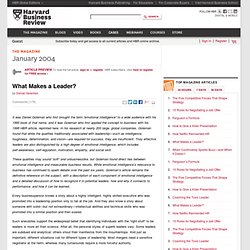
Canada must make profound changes to succeed: Lynch. Kevin Lynch offers stark choices for Canada in recent public lectures. by Rosanna Tamburri In a quickly changing world marked by increased globalization, a shift in the balance of economic power towards emerging economies, and a shrinking workforce, Canadian governments, businesses and universities will have to make profound changes, said Kevin Lynch, a former high-ranking civil servant and currently vice-chairman of BMO Financial Group.
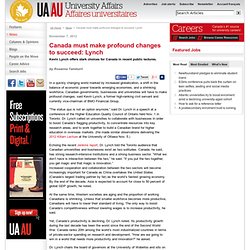
“The status quo is not an option anymore,” said Dr. Lynch in a speech at a conference of the Higher Education Quality Council of Ontario held Nov. 1 in Toronto. Dr. Echoing the recent Jenkins report, Dr. At the same time, Western societies are aging and the proportion of working Canadians is shrinking. Yet, Canada’s productivity is declining, Dr. Dr. In his Toronto speech, Dr. Canadian universities should also concentrate resources into areas of key research strengths. But winning high-profile prizes will require making choices, he added. Dr. Knowledge Media Institute. Alumni Member Professor of Learning Informatics My work is inspired by the vision and >40 years’ work of pioneer Doug Engelbart: to develop technologies which “augment human intellect”, our “collective capability for coping with complex, urgent problems.”
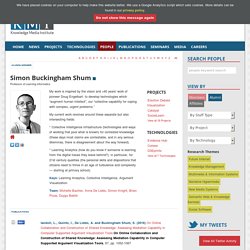
My current work revolves around these separate but also intersecting fields: * Collective Intelligence infrastructure (technologies and ways of working that pool what is known) for contested knowledge (these days most claims are contestable, and in any serious dilemmas, there is disagreement about the way forward). * Learning Analytics (how do you know if someone is learning from the digital traces they leave behind?) Three Big Changes Ahead for Higher Education. “The world as we have created it is a process of our thinking.
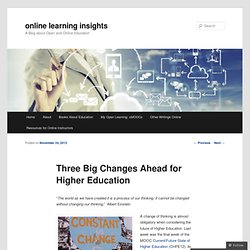
It cannot be changed without changing our thinking.” Albert Einstein A change of thinking is almost obligatory when considering the future of Higher Education. Last week was the final week of the MOOC Current/Future State of Higher Education (CHFE12); its overarching objective was to explore the influences and pressures facing universities today and to identify where higher education is headed.
Predictive Analytics Reporting (PAR) Framework. Good practices and sound policies that accelerate the effective adoption and use of technologies in teaching and learning.
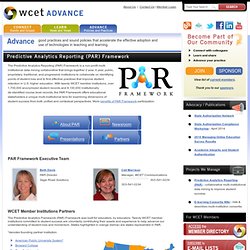
The Predictive Analytics Reporting (PAR) Framework is a non-profit multi-institutional data mining collaborative that brings together 2 year, 4 year, public, proprietary, traditional, and progressive institutions to collaborate on identifying points of student loss and to find effective practices that improve student retention in U.S. higher education. With twenty WCET member institutions, over 1,700,000 anonymized student records and 8,100,000 institutionally de-identified course level records, the PAR Framework offers educational stakeholders a unique multi-institutional lens for examining dimensions of student success from both unified and contextual perspectives.
More benefits of PAR Framework participation. PAR Framework Executive Team. Big Data in K-12: Attack of the Recommendation Engines – Part I. Big Data in K-12: Attack of the Recommendation Engines – Part I Nelson B.
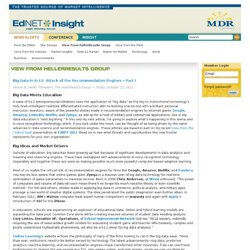
Heller, President, The HellerResults Group — Friday, October 12, 2012 Big Data Meets Education A wave of K-12 entrepreneurial initiatives sees the application of “big data” as the key to instructional technology’s Holy Grail—intelligent real-time differentiated instruction akin to working one-on-one with a brilliant personal instructor. Game Changers: Education and Information Technologies. Registration - Current/Future State of Higher Education. Transitioning to Blended Learning (3 Reflections/Questions) « grandprospirator. Enhancing Student Learning and Retention with Blended Learning Class Guides (EDUCAUSE Quarterly. Key Takeaways Experience has shown that well-designed hybrid courses enhance student learning and increase student retention, even in large introductory science classes.
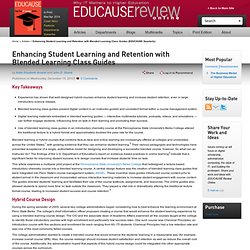
Blended learning class guides present digital content in an instructor-guided and consistent format within a course management system. Digital learning materials embedded in blended learning guides — interactive multimedia tutorials, podcasts, videos, and simulations — can further engage students, influencing time on task in their learning and promoting their success. Use of blended learning class guides in an introductory chemistry course at the Pennsylvania State University's Berks College altered the traditional lecture to a hybrid format and approximately doubled the pass rate for the course. This article examines a multiyear pilot project at the Pennsylvania State University's Berks College that redesigned a lecture-based introductory chemistry course into a blended learning course. Hybrid Course Design Figure 1. UniversityNow - Making Higher Education Available for Everyone. DeMillo: Traditional Universities Fear Online Education.
Most of the pushback against online education is being driven by fears that it will supplant the traditional instructional paradigm, according to Richard A.
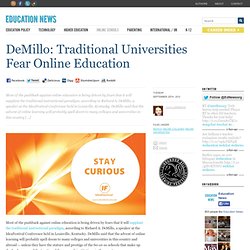
DeMillo, a speaker at the IdeaFestival Conference held in Louisville, Kentucky. DeMillo said that the advent of online learning will probably spell doom to many colleges and universities in this country and abroad — unless they have the stature and prestige of the 60-or-so schools that make up the Ivy League and the top tier of the research institutions in the country. For DeMillo, the sheer volume of knowledge now being disseminated over the internet presents a destructive force to the way that higher education currently works. In his capacity as the director of the Center for 21st Century Universities at the Georgia Institute of Technology, he has firsthand knowledge of how panicked college administrators seem over the growing popularity of online learning. Knowledge Media Institute.